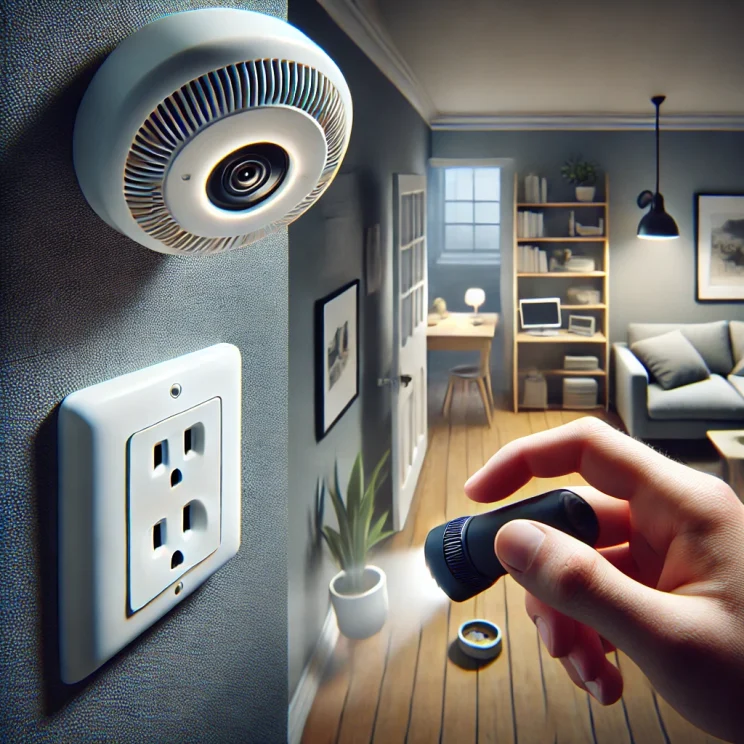Types of fire detectors
Fire detectors are key components of a fire safety system designed for early detection of fire hazards. They can quickly respond to various factors such as smoke, steam or temperature changes, alerting to potential fire threat. There are several types of detectors, each designed for specific conditions and room types ensuring maximum protection efficiency.
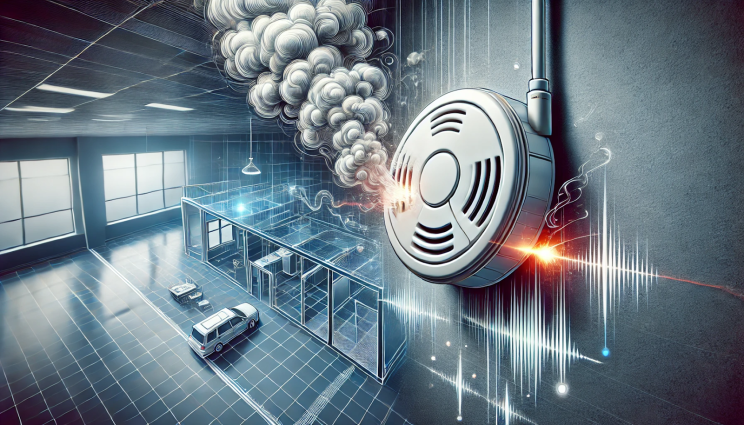
Fire detectors play a key role in ensuring safety, as their timely activation helps significantly reduce risks to life and minimize damage. An effective fire alarm system not only notifies employees and visitors in time about the need to evacuate, but also automatically activates fire protection systems such as sprinklers or fire extinguishers. Investing in high-quality fire detectors is key to the safety and stability of your business.
The importance of early fire detection: why you should prioritize fire alarms
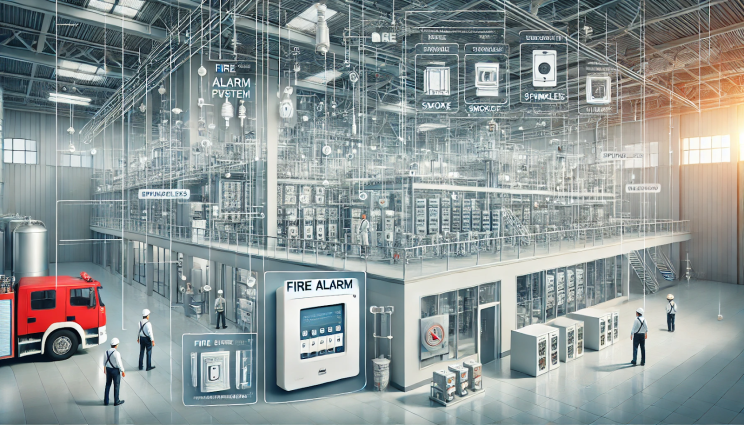
Early blaze detection is crucial for safety in both businesses and homes. A quick response to the first signs of fire helps to save lives, minimise damage and prevent the spread of flames. Modern fire alarm systems provide timely notification, enabling evacuation measures to be taken quickly and fire protection systems to be activated.
Key reasons why businesses and residential buildings need effective warning systems include:
- Saving lives: Immediate notification of a blaze allows for rapid evacuation of people, reducing the risk of injury and loss of life.
- Minimising material losses: Rapid fire detection limits spread, protecting property and equipment from significant damage.
- Reduced response time: Modern systems integrate with local emergency services to ensure firefighters arrive on the scene quickly.
- Regulatory compliance: Installing a fire alarm system is mandatory by law, which helps you avoid fines and legal consequences.
- Maintaining Business Continuity: Rapid response to fire threats minimize downtime and ensuring business continuity.
- Increased confidence: A reliable fire safety system builds trust among employees, customers and partners, showcasing your commitment and responsibility.
- Staff Training and Readiness: Advanced systems often include automatic drills and alerts, increasing employee preparedness for emergencies.
Investing in reliable fire sensors and warning systems is not just about meeting safety standards, but a well-thought-out strategy to protect lives and business stability. The use of modern technology helps to create an effective multi-level system capable of responding to any blaze threat in a timely manner and ensuring maximum safety.
Fire detectors from ABC Berkut – a leader in security services
A reliable fire safety system is the foundation of any company’s defence. Modern sensors allow timely detection of threats, minimising risks and preventing the blaze development. ABC Berkut is a leading expert in Kazakhstan in the installation of fire alarm systems, offering effective and technological solutions for comprehensive security.
The company’s unique opportunities
ABC Berkut stands out in the market due to a comprehensive approach and the implementation of the newest technologies in the fire protection system. The company offers a wide range of sensors adapted to different operating conditions:
- Smoke detectors: Highly sensitive sensors that can react quickly to the slightest sign of smoke, preventing the spread of flames.
- Thermal sensors: Specialised devices that detect sudden changes in temperature, allowing timely detection of the blaze beginning even in the absence of smoke.
- Gas detectors: Detect flammable gas leaks, preventing potential explosions and chemical fires.
- Combined sensors: Integrated devices combining the functions of smoke and heat sensors for more accurate and faster fire detection.
Examples of technological solutions
The company implements innovative technologies to maximise the efficiency of fire protection systems:
- Smart monitoring systems: Using advanced algorithms to analyze sensor data to minimizing false alarms and enhancing detection accuracy.
- Alert Automation: Systems that automatically notify dispatchers and mobilize response teams when sensors are triggered, accelerating the reaction process.
- Integration with other security systems: Combining fire sensors with access control systems (ACS) and video surveillance to create multi-level protection of the facility.
Benefits of choosing a professional who guarantees an immediate response to smoke damage
Choosing ABC Berkut as your partner for installing fire protection systems offers many benefits:
- Rapid Response: The company’s specialists can promptly arrive at the site when sensors are triggered, ensuring the timely mitigation of the threat.
- Professional Installation: Berkut’s experienced ABC installers ensure accurate adjustment and optimal placement of the sensors, which increases their efficiency.
- Regular maintenance: We offer system maintenance and inspection services to ensure smooth operation and durability.
- Staff Training: The company provides training to employees of enterprises on the correct use of fire protection systems and actions in case of an alarm.
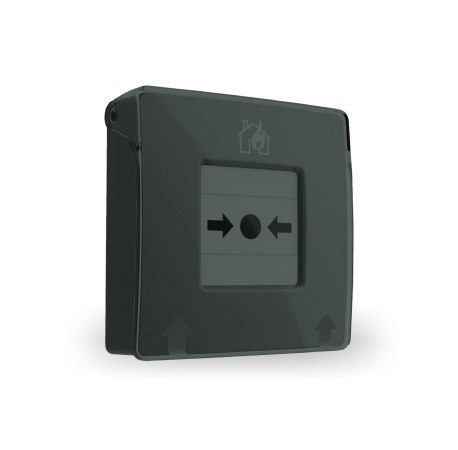
Installation of fire safety systems in Astana
ABC Berkut has established itself as a leading fire alarm installation expert in Astana. The company has successfully carried out numerous projects, from office buildings to industrial plants. With its in-depth knowledge of local regulations and infrastructure, the company offers tailored solutions that meet the highest standards of quality and reliability.
Installation of fire safety systems in Almaty
ABC Berkut also holds a leading position in providing installation and maintenance services for fire detectors in Almaty. The company works with a wide range of clients, offering customised fire alarm systems that meet the specific requirements of each facility. The company’s highly qualified specialists ensure not only quality installation but also ongoing support, making the company the preferred choice for fire safety in Almaty.
ABC Berkut provides complete solutions for the fire detector installation, combining the latest technology, professionalism and a personalised approach to each client. It gives you reliable protection for business and the confidence to respond quickly and effectively in the event of a blaze.
Main types of sensors: smoke, heat and flame detectors
Fire protection sensors are a crucial element in the security of various facilities, be it residential premises, offices or industrial plants. A wide range of detectors makes it possible to choose the best solution depending on the premises type and possible threats. Let’s consider the main kinds of fire sensors – smoke, heat and flame – their features and the conditions under each of them work most effectively.
Smoke detectors
Smoke sensors are designed for the early detection of small smoke particles, enabling a timely response to the onset of a blaze. They are ideal for areas with high foot traffic, such as offices, shopping malls and residential buildings.
Smoke detectors features:
- High sensitivity to smoke, which ensures quick activation at the slightest sign of haze.
- They are optimal for well ventilated rooms where smoke can spread quickly.
- Used in residential and public places where early fire warning is crucial.
Thermal sensors
Heat sensors respond to a sudden increase in temperature or a specific heat threshold, making them indispensable in environments where noise or dust levels are high, which can cause false alarms with smoke sensors.
Thermal sensor features:
- Low sensitivity to smoke and dust, minimising false alarms.
- Effective in industrial areas and warehouses where dust, steam or intense heating are present.
- Used in kitchens and technical rooms where smoke detectors can frequently activate without a real blaze hazard.
Flame sensors
Flame sensors are designed to detect open flames and their characteristics, such as infrared or ultraviolet radiation. They provide an immediate response to an active fire, preventing the rapid blaze spread.
Flame Sensor Features:
- High accuracy in the detection of open flames, minimising the response time to an active fire.
- Ideal for high-risk fire areas, such as laboratories, warehouses with flammable materials and manufacturing workshops.
- Able to distinguish real flames from other light sources, reducing the risk of false alarms.
Selecting the optimal sensor type
When selecting fire detectors, it is important to consider the specifics of the object and potential threats. In most cases, the best solution is to use a combination of different sensor types, providing multi-layered protection and enhancing the overall efficiency of the fire alarm system.
Key factors in sensor selection:
- Room type and size – the choice of sensors depends on the area and layout of the space.
- Nature of activity – industrial facilities require more specialized solutions compared to residential buildings.
- Operating conditions – high humidity, dust or the presence of vapours can influence the choice of sensor type.
Our company offers a wide range of fire detectors tailored to various operating conditions. Our experienced specialists will select and install the optimal solutions, ensuring a high level of fire protection for your facility. The use of advanced technologies and a professional approach guarantee the reliability and efficiency of fire alarm systems, making them an essential part of a comprehensive security solution.
Working principle: How sensors detect smoke, gas or temperature changes
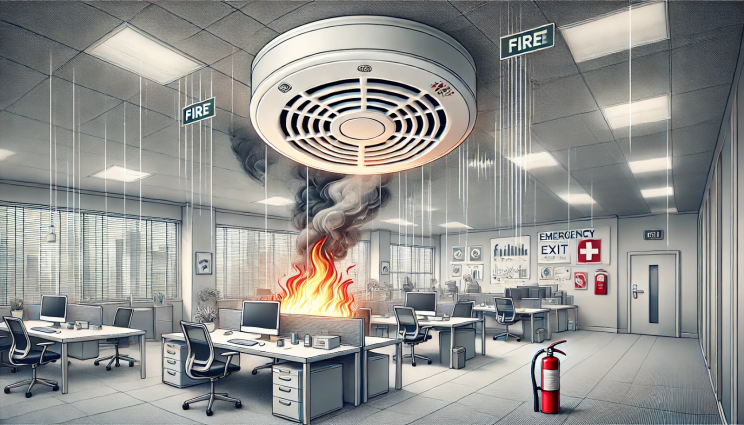
Fire detectors play a crucial role in fire safety systems, providing early detection of signs of blaze and timely notification. Each type of sensor is designed to respond to specific elements contributing to the fire, thus effectively preventing its development.
Smoke detectors
Smoke sensors detect fine smoke particles generated at the early stages of a fire. There are two main types of smoke sensors:
- Ionization detectors use a radioactive isotope that ionize the air inside the sensor. When smoke enters the chamber, it disrupts the ionization, altering the electric current and triggering the alarm.
- Photoelectric detectors operate using a light beam and a photo detector. Under normal conditions, the beam passes unobstructed, but when smoke enters, it scatters the light, which is detected by the sensor and activating the alarm.
Smoke sensors are particularly useful in highly active areas, such as offices and residential buildings, where it is essential to quickly detect the first signs of blaze.
Thermal sensors
Heat sensors detect temperature increases or sudden changes in the thermal background. They analyse the temperature change rate and activate when the set threshold is exceeded. There are two main types of sensors:
- Linear heat detectors monitor a gradual rise in temperature and activate once a specific threshold is reached.
- Rate of rise heat detectors triggered when the temperature increases rapidly, allowing fire detection even in the absence of significant smoke.ого дыма.
Thermal sensors are ideal for areas with high humidity, dust or vapour where smoke detectors can often give false alarms. They are widely used in warehouses, technical rooms and manufacturing workshops.
Gas detectors
Gas sensors are designed to detect leaks of flammable or toxic gases such as carbon monoxide, methane or propane. Their operation is based on changes in the air’s chemistry composition, which alter the sensor’s electrical properties:
- Electrochemical sensors respond to specific gases by changing their electrical resistance. When the gas concentration exceeds a safe level, the sensor activates an alarm.
- Catalytic sensors use a heated catalyst plate that oxidises combustible gases. This process changes the sensor’s temperature, triggering the alarm.
Gas sensors are indispensable in industrial facilities, laboratories and kitchens where gas leaks that could lead to explosions or poisoning may occur.
Combined sensors
Combination sensors integrate the capabilities of multiple detectors, e.g. smoke and heat, to provide more accurate blaze detection and reduce the potential for false alarms. They are particularly effective in complex environments where different factors can affect the performance of individual sensor types.
Automation & Integration
Modern fire safety systems integrate various types of sensors into a unified network, ensuring comprehensive monitoring of the facility. Automation not only detects signs of blaze, but also promptly notifies personnel, triggers fire-fighting mechanisms and alerts emergency services. This accelerates the response to threat and enhances overall defence effectiveness.
By understanding the unique characteristics of fire detectors, it is possible to select the optimal solution for specific conditions. A system that combines smoke, heat and gas sensors provides a multi-layered defence, capable of identifying threats in a timely manner and preventing their escalation. This is a crucial safety factor that helps protect lives and property.
Installation guidelines and standards: how many sensors are required in a roomужно в помещении
A successful fire safety system begins with the proper selection and installation of fire sensors. Correct placement and sufficient ones are crucial for timely detection of blaze and prevention spread. Consideration of key regulations and recommendations is important to help determine the optimal device placement for maximum facility protection.
Number of fire protection sensors
The number of fire detectors required depends on several factors:
- Room size: The larger the space, the more detectors are required for full coverage.
- Type of premises: Offices, warehouses, production facilities and residential buildings have different requirements for the number of detectors.
- Occupancy level: High-traffic areas require more frequent sensor placement for fast smoke or fire detection.
- Architectural features: Partitions, niches and high ceilings may require additional sensors.соров.
The optimal number of fire detectors is calculated based on the room size – on average, one sensor is installed for every 10-15 square metres. In buildings with multiple rooms, zoning should be taken into account: hallways, kitchens and utility rooms may require additional detectors depending on the specifics of space usage.
Optimal placement of fire sensors
Correct placement of the sensors will maximise their effectiveness. Follow these recommendations for the best possible installation:
- Installation height: Smoke detectors should be mounted on the ceiling or at least 30 cm from the wall, as smoke naturally rises. Heat sensors are typically installed at a height of about 1.5 metres.
- Sensor spacing: Maintain a minimum distance of 6 metres between detectors to prevent overlapping detection zones and ensure even coverage of the area.
- Proximity to potential fire sources: Install detectors near kitchens, technical areas and other high-risk fire zones.
- Avoid high humidity areas: Bathrooms and kitchens can trigger false alarms. To prevent this, place smoke detectors at least 3 metres away from steam and moisture sources.
- Continuous monitoring of evacuation routes: Position detectors along corridors and near exits to ensure timely alerts in case of emergency evacuation.
Regulations and technical requirements
During the installation a fire detector must comply with the applicable regulations and technical standards to ensure reliable operation and compliance with safety requirements:
- Compliance with local standards: In Kazakhstan and other countries, there are specific regulations and standards for fire alarm installation. Be sure to familiarise yourself with these requirements before starting any work.
- Quality of equipment: Use certified fire detectors from trusted manufacturers to ensure their reliability and longevity.
- Professional installation: Hire qualified experts to install fire alarm systems. Incorrect installation can reduce the effectiveness of the detectors and cause malfunctions.
- Regular Maintenance: Perform regular inspections and maintenance of fire alarm systems to ensure they are in optimal condition and ready to operate at any moment.
- Documentation and reports: Maintain records of installed sensors and inspections conducted, as this will aid in fire safety audits and inspections.
The correct selection of the number and placement of fire detectors is essential for creating an effective security system. Adhering to all regulatory and technical standards, using high quality equipment and ensuring professional installation significantly increase the chances of timely blaze detection and help prevent its spread. By investing in reliable sensors and following all recommendations, you ensure the safety of your business and protect employee lives.
Inspection and maintenance: How to recognise correct sensor function
The reliable operation of fire detectors requires regular inspection and maintenance. This ensures not only the timely detection of flames, but also extends the equipment’s lifetime. Let’s look at the basic steps and recommendations for maintaining sensors in working order.
Regular sensor testing
Monitoring and testing fire detectors regularly is a key element of reliable operation. We recommend testing at least once a month. To do this follow the steps below:
- Using the test button: Most sensors are equipped with a test button. Press it to verify that the alarm is functioning properly. If the alarm does not sound, the battery may need to be replaced or the unit may require repair.
- Smoke Simulation: For smoke detectors, a special light smoke spray can be used. This helps to test the sensor’s sensitivity to smoke. Avoid using real fire or heavy smoke to prevent damage to the device.
- Checking heat sensors: For heat sensors, you can gently hold a heat source, such as a hot lamp, near the sensor for a few seconds. Ensure the sensor reacts to the temperature increase and activates the alarm.
Replacement of batteries
Batteries are an essential component in the smooth operation of sensors. Follow the recommendations below to avoid malfunctions in your security system:
- Battery lifespan: Typically, batteries in detectors last from 6 months to a year. Pay attention to low charge indicators, which signal the need for replacement.
- Regular replacement: Plan battery changes in advance to avoid unexpected sensor shutdowns. It is best to replace batteries at the same time, such as every six months.
- Use quality batteries: Choose batteries from trusted manufacturers to ensure stable sensor operation and extend their lifespan.
Beeping sensor: causes and actions
If your fire detector begins to beep, it could indicate several possible problems:
- Low battery: One of the most common causes of beeping. In this case, the battery should be replaced immediately to restore the sensor’s functionality.
- Clogged or contaminated: Dust, dirt or cobwebs can interfere with the sensor’s operation. Regularly cleaning of the sensor with a soft, dry cloth help prevent false alarms and maintain its performance.
- Equipment malfunction: If the sensor continues to beep after replacing the battery and cleaning, the unit may be defective and require replacement or repair by a professional.
- False Alarms: Sometimes, sensors may react to steam, perfumes, or other minor airborne pollutants. Ensure the sensor is installed in an appropriate location, away from kitchens and bathrooms, to minimize false alarms.
Maintenance recommendations
To ensure the long-term reliability of fire detectors, follow these tips:
- Professional inspection: It is recommended to have a specialist conduct a comprehensive inspection of the entire fire alarm system once a year. This will help identify any hidden issues and perform necessary maintenance.
- Maintenance documentation: Keep a detailed maintenance log where you record inspection dates, battery replacements and any work performed. This will help you monitor the system’s condition and respond promptly to any changes.
- Staff training: Train employees on the proper use of fire detectors, including testing procedures and actions to take in case of an alarm. This will enhance the overall safety of the facility.
Regular inspection and maintenance of fire detectors ensures efficient operation and reliable protection of your business. Following the recommendations for testing, battery replacement and fault rectification helps to detect blazes in good time and reduces risks to life and property. By investing in ensuring fire alarm system is kept in perfect condition, you create a safe working environment.
Common mistakes and myths: when sensors mistake ‘cigarette smoke’, steam and system readiness issues
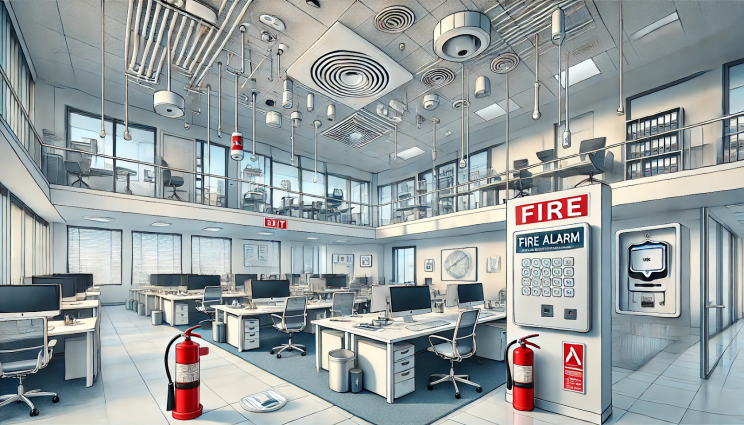
Fire detectors are an essential component of any fire safety system. However, in everyday use, they may encounter situations that trigger false alarms. There are many myths and misconceptions about what exactly these sensors react to and how to avoid unnecessary alarms. Let’s debunk the most common mistakes and myths related to the operation of fire sensors.
False alarms caused by cigarette smoke
One of the most common myths is that smoke detectors are triggered by cigarette smoke. In fact, modern ionisation and photoelectric sensors are able to distinguish dense smoke from cigarette, greatly reducing the chance of false alarms. However:
- Ionisation sensors can react to smoke particles, so it is better to place in areas where smoking is prohibited.
- Photoelectric sensors are less sensitive to the fine particles characteristic of cigarette smoke, making them more suitable for public areas.
Reaction to kitchen steam
Kitchen steam is a common cause of smoke detector activation in residential and commercial applications. The steam can cause false alarms, especially if the detectors are installed too close to the kitchen. How to avoid it:
- Placement of detectors: Install smoke detectors at a safe distance from kitchen areas, preferably at least 3 metres away.
- Use of combined sensors: These devices integrate smoke and heat sensors, improving the ability to differentiate between steam, smoke and real fire hazards.
- Proper Ventilation: Maintain good air circulation in the kitchen by using range hoods and fans to prevent steam build-up around the detectors.
Effect of humidity and dust
High humidity and dust can adversely affect the performance of fire detectors, particularly in technical and production facilities. These factors may trigger false alarms or reduce sensor sensitivity. Here a some recommendations to prevent these issues:
- Regular cleaning: Periodically wipe the sensors with a soft, dry cloth to remove dust and dirt.
- Choosing the right sensors: In high humidity environments, opt for thermal sensors or combined detectors, as they are less affected by steam and dust.
- Protecting the sensors: Install protective grilles or covers to prevent large dust and dirt particles from accumulating on the sensors.
Incorrect installation and technical malfunctions
Many users incorrectly believe that false alarms are caused by improper sensor installation. In fact, wrong placement and technical faults can significantly increase the probability of alarms:
- Proper placement: Follow installation guidelines, considering ceiling height, distance from potential smoke sources, and room ventilation.
- System inspection: Regularly test the sensors and check the battery status. A beeping alarm often indicates the need for battery replacement or device maintenance.
- Professional installation: Hire qualified professionals to install and configure fire protection systems ensuring their proper operation and minimizing the risk of false alarms.
Myths about security system readiness
There is a perception the installation of fire detectors automatically provides complete defence against blazes. In fact, the effective safety depends on several factors:
- A comprehensive approach: Fire detectors should be integrated into a broader security system that includes alarm systems, evacuation plans and employee training.
- Regular maintenance: Routine inspection and maintenance is the only way to ensure that the system functions reliably in case of emergency.
- Employee training: Staff should be well-trained in responding to alarm activations to ensure a quick and appropriate reaction to potential threats.
False alarms and misconceptions about fire detectors can create unnecessary inconvenience and undermine confidence in the security system. Understanding how these detectors function, ensuring proper installation and performing regular maintenance help minimize false triggers caused by everyday factors such as cigarette smoke or kitchen fumes. By following expert recommendations and consulting professionals, you can ensure reliable protection for your business or home, maintaining safety and peace of mind for everyone involved.
In conclusion: security as a priority and the role of an integrated approach

Ensuring enterprise security is a key aspect in sustainable development, safeguarding both property and employees’ lives. A comprehensive protection approach involves the competent selection and installation of various types of sensors, their regular maintenance and elimination of possible system failures. Early blaze detection using smoke, heat and gas sensors minimizes the risks of fire spread and enables a rapid emergency response.
Our company provides a full fire safety services, covering from consultation and alarm system design to professional installation and regular maintenance. ABC Berkut specialists carefully analyze the peculiarities of each object, selecting optimal solutions and ensuring their seamless operation. When you turn to professionals, you gain not only reliable fire protection, but also confidence in the safety of your business or home. Make safety your priority – trust our experts to protect your property at the highest level.


